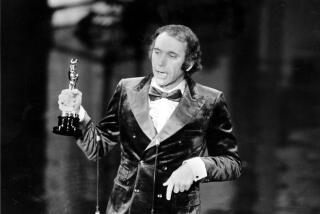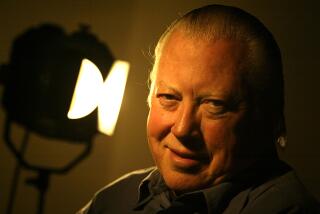‘Godfather’ Goodies
Francis Ford Coppola offers commentary you can’t refuse on Paramount’s super-deluxe “The Godfather DVD Collection” ($75). The five-disc set includes all three “Godfather” epics, plus three hours of bonus goodies.
A master filmmaker, Coppola is also a master storyteller in his commentaries, especially with “The Godfather,” his 1972 Oscar-winning adaptation of Mario Puzo’s best-selling novel.
“The Godfather,” Coppola stresses, was not a pleasant experience for him. Executives at Paramount were not happy with his casting of Marlon Brando as Don Corleone and the newcomer Al Pacino as son Michael Corleone. On several occasions, Coppola was nearly replaced because the studio brass wasn’t happy with the rushes. Pacino was also on the verge of being replaced until executives saw the bravura scene in which Michael avenges his father’s near-fatal shooting.
Though Nino Rota’s score was an instant classic when the film was released, Coppola says that Paramount executive Robert Evans hated the music. He made a deal with Evans that if a test audience didn’t like the music, he would replace it. The audience endorsed his view, and it stayed.
The affectionate cat that Brando had on his lap during the film’s opening was found roaming around the set. Coppola says he gave it to the actor as a prop and the two quickly took to each other.
Coppola also reports that he received heated letters from animal activists regarding the horse’s head that is found in the bed of Hollywood producer Jack Woltz (John Marley). They thought the filmmakers had killed a horse for the scene. It was in fact a real head, Coppola says, but it came from a slaughterhouse where horses were being destroyed for dog food. He says a member of the production went to the company, chose a horse that resembled Woltz’s prized thoroughbred and asked that when the time came, the head be sent to the filmmakers. Shortly thereafter, the company sent them a box with the head wrapped in ice.
The first four discs in the set contain the three movies (“Godfather II” takes two). The extras are on Disc 5 and include “The Godfather: A Look Inside,” a 1990 documentary offering an in-depth look at the films’ origins, with footage of rehearsals and original screen tests. Other featurettes on the disc are devoted to the films’ music, cinematography, production design and scripts. There also are a plethora of additional scenes (several were added to later versions of the original films); storyboards from “The Godfather Part II”; computerized storyboards from “Godfather III”; cast and character biographies; clips of “Godfather” winners making their Oscar acceptance speeches; photo galleries with captions; filmmakers’ biographies; and trailers.
*
Kino on Video’s “The Strong Silent Type” DVD collection features four classics of the silent film era: ($30 each): “The Gaucho,” “The Penalty,” “Dr. Jekyll and Mr. Hyde” and “Blood and Sand.”
“The Gaucho,” from 1928, is a comedy thriller starring Douglas Fairbanks as an Argentine ne’er-do-well. Also featured on the disc are excerpts from the movie’s original souvenir program and Fairbanks’ truly bizarre 1916 cult comedy “The Mystery of the Leaping Fish,” in which he plays a drug-fiend detective called Coke Ennyday.
Lon Chaney gives a terrifying performance in 1920’s “The Penalty” as a criminal mastermind whose legs were amputated as a young boy. Supplemental material includes a tour of Chaney’s makeup case and costumes, conducted by the actor’s biographer, Michael F. Blake; an essay by Blake; the original trailers for Chaney’s “The Big City” and “While the City Sleeps”; the only surviving footage of his film “The Miracle Man”; a production budget and a gallery of photos and artwork.
Also from 1920 is “Dr. Jekyll and Mr. Hyde,” considered by many historians to be the first great American horror film. A young, robust John Barrymore makes an indelible impression as Robert Louis Stevenson’s tragic hero. Among the extras are a 1909 audio recording of an actor performing the transformation scene; a 1925 parody, “Dr. Pyckle and Mr. Pride,” starring Stan Laurel; and some scenes from another 1920 version starring Sheldon Lewis.
No actor flared his nostrils in quite the same way as Rudolph Valentino did in 1921’s “Blood and Sand,” in which the silent-screen legend smolders as a celebrated toreador. This DVD restores 20 minutes of footage missing from a previous Kino DVD release. Other goodies include a 1924 parody of the film starring Will Rogers; the trailer; footage of Valentino’s funeral procession; and an excerpt from Photoplay magazine in which Valentino discusses women.
*
Home Vision kicks off its new DVD line with several vintage Brigitte Bardot films, including 1958’s tawdry wallow, “The Night Heaven Fell” ($30), written and directed by Roger Vadim, who had guided his then-wife in the legendary sex drama “And God Created Woman.”
More to Read
Only good movies
Get the Indie Focus newsletter, Mark Olsen's weekly guide to the world of cinema.
You may occasionally receive promotional content from the Los Angeles Times.











